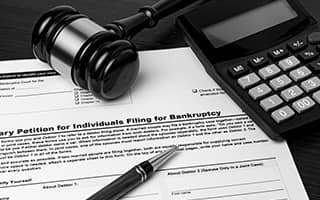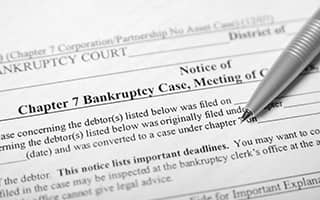Instant Court Case Lookup
The following is for information purposes only
Bankruptcy
When debt payments are far higher than borrowers' monthly income, it becomes impossible to carry. This is when there's an increase in bankruptcy filings.

What Is Bankruptcy?

The bankruptcy process is a legal way of involving a person or company that cannot pay its debts. This allows them freedom from their debts while simultaneously providing lenders an opportunity for repayment.
Bankruptcy proceedings start with a petition submitted by the debtor on behalf of creditors, depending on which is more common. The debtors' assets are all measured and analyzed and used to pay a portion of the outstanding debt.
In the United States, federal courts handle all bankruptcy matters. A bankruptcy law judge makes all decisions in federal bankruptcy cases. This includes whether a debtor is eligible to file, reorganize, restructure or erase their debts altogether.
In the proceeding, administration over bankruptcy cases falls on a bankruptcy attorney representing the debtor's real estate. Unless a creditor raises an issue in the case, there is usually minimal direct contact between the debtor and the bankruptcy court.

What Are the Different Types of Bankruptcy?
There are a few different types of bankruptcy to understand. From personal defaults, and corporate bankruptcies to business bankruptcies, below are six different types of bankruptcies and how they work:
- Chapter 7 bankruptcy: Liquidation - This is the most common bankruptcy type used by individuals. The liquidation of assets pays off creditors and clears unsecured debt such as credit cards or medical bills.
- Chapter 9 bankruptcy: This payment plan allows towns, cities, and school districts to reorganize and pay back the monies owed.
- Chapter 11 bankruptcy: This helps reorganize a business or corporation. The business works with the court to come up with a plan on how to pay off their debts and continue operations. The court and creditors must approve the plan before it can be implemented.
- Chapter 12 bankruptcy: This repayment plan helps family farmers and fishers avoid foreclosure on their property. While this plan is similar to Chapter 13 bankruptcy, it's more flexible and has higher debt limits.
- Chapter 13 bankruptcy: This repayment plan is a reorganization of debts. The court must approve a monthly payment plan to help pay back a portion of unsecured debt. Secured debts typically need to be paid back within three to five years.
- Chapter 15 bankruptcy: For international bankruptcy issues.

How Is Bankruptcy Filed?

There are a few steps to take in preparing to file for bankruptcy, these include:
- Collecting documents - financial documents are essential for understanding someone's financial state.
- Going to credit counseling is compulsory six months before filing for bankruptcy.
- Completing all the necessary U.S. bankruptcy code forms amounts to over 23 separate documents. These forms ask about everything made, spent, owned, and owed.
- Collecting a filing fee - If a person cannot pay upfront, they can pay the price in smaller monthly installments.
- Printing bankruptcy forms - only single-sided papers accepted; each page needs a signature.
- Visit the courthouse to file bankruptcy forms - You can file forms with the court clerk who then uploads the information to the court's online filing system. You can accomplish this in less than 15 minutes.
- Sending documents to an appointed trustee - who will oversee the case and liquidate or sell a nonexempt property for the benefit of the creditors.
- Completing a bankruptcy course - helps make intelligent financial decisions in the future. This course includes how to use the United States courts bankruptcy protection program.
- Meet with your creditors - the purpose of this meeting is to verify a debtor's identity. A few general questions are asked. These questions are based on student loans, child support, and insolvency records.

What Happens After Filing for Bankruptcy?
After declaring bankruptcy, the recovery process has proven long and complex. Bankruptcy can affect one's reputation in several different ways. A few of these ways include the following:
- Liquidated assets and the quality of life that once was, is no longer.
- You may not be able to get a loan of any kind.
- Credit scores will decrease significantly.
- Travel restrictions tied to the person's name.
- Bankruptcy typically stays on your credit report for ten years.
However, recovery from bankruptcy is possible. Here are five steps individuals can follow to help on a journey to recovery:
- Maintaining a job and a home. Stable employment and residential histories are necessary for proving reliability to creditors.
- Paying bills. There cannot be room for mistakes in this regard. It is imperative to ensure that income covers all expenses.
- Keeping a bank balance. Having available cash flow shows creditors your situation is improving.
- Credit rebuilding. A credit card is necessary for this. People who wisely use borrowed money build up their trustworthiness.
- Assistance with car loans and mortgages. Creditors may require other partnerships to cosign on loans for more significant debts. Close friends or family members are typical examples of this.

Where Are Bankruptcy Records Found?
Bankruptcy records are available to the public. It is possible to access documents through the clerk's office (during business hours) or via the internet. For sealed bankruptcy records, access requires a court order.

Are There Alternatives to Filing for Bankruptcy?
Filing for bankruptcy is known as a last resort as it affects one's life tremendously. No matter how much debt there is, there is always hope. Understanding the different options that help with debt relief will help make the best decision. Here are the steps you must follow to file for bankruptcy:
- Putting necessities first. Individuals should only cover basic needs. These include food, utilities, shelter, and transportation.
- Sticking to a strict budget. This means getting rid of all unnecessary expenses. Some of these include subscriptions, cable, dining out, and vacations.
- Increasing income. Finding a second job or sacrificing time to work more hours is crucial in debt repayment. While it is exhausting, it's worth the freedom in the long run.
- Selling possessions. Selling unnecessary possessions will settle those debts even faster. One should sell luxury items such as fancy hair straighteners, lawnmowers, guitars, and jewelry. Use online marketplaces like eBay, Craigslist, and Facebook Marketplace to sell your valuables.
- Financial education. Learning how to kick toxic money habits by taking a financial literacy course. These courses can help with savings and paying off debts.